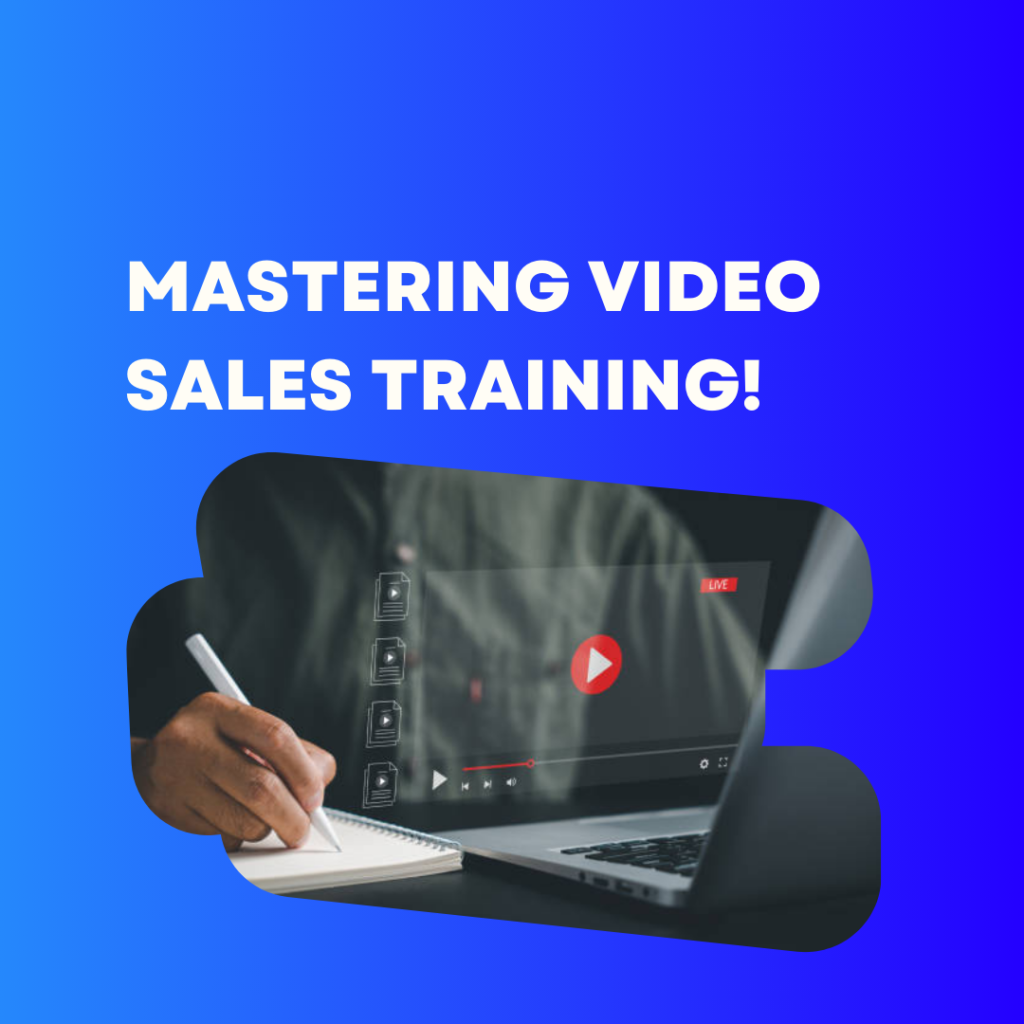In today’s competitive business landscape, companies are continuously seeking innovative ways to train their sales teams. One such method that has gained immense popularity is video sales training. Combining the power of visual content with effective training strategies, video sales training has proven to be a game-changer for many organizations. In this comprehensive guide, we will explore the various aspects of video sales training, its benefits, best practices, and how to implement it effectively within your organization.

Introduction to Video Sales Training
Video sales training is an innovative approach that uses video content to train sales teams on various skills, techniques, and strategies required to excel in their roles. Unlike traditional training methods, which often rely on in-person sessions or static content, video sales training leverages dynamic visual elements to create engaging and interactive learning experiences.
In recent years, video sales training has become increasingly popular due to its flexibility, scalability, and ability to cater to different learning styles. Whether it’s a small startup or a large multinational corporation, organizations of all sizes can benefit from incorporating video sales training into their overall training strategy.
Benefits of Video Sales Training
Implementing video sales training can offer numerous benefits to both the organization and the sales team. Some of the key advantages include:
Enhanced Engagement and Retention:
- Visual Learning: Videos cater to visual learners, making it easier for them to understand and retain information.
- Interactive Elements: Incorporating quizzes, polls, and interactive scenarios can boost engagement and ensure active participation.
RELATED ARTICLE: How to Screen Record on Chromebook?
Cost-Effective and Scalable:
- Reduced Training Costs: Video training eliminates the need for physical training sessions, travel expenses, and printed materials.
- Scalability: Training videos can be easily distributed to a large audience, making it ideal for organizations with geographically dispersed teams.
Flexibility and Convenience:
- On-Demand Access: Sales reps can access training videos anytime, anywhere, allowing them to learn at their own pace.
- Consistent Training: Ensures that all team members receive the same high-quality training, regardless of their location.
Improved Performance and Results:
- Real-World Scenarios: Videos can simulate real-world sales scenarios, helping reps develop practical skills and techniques.
- Performance Tracking: Analytics tools can track viewer engagement and progress, providing insights into the effectiveness of the training program.
Key Components of Effective Video Sales Training
To create an effective video sales training program, it is essential to include certain key components. These elements will ensure that the training is comprehensive, engaging, and impactful.
- Clear Learning Objectives
Define specific learning objectives for each video module to provide a clear focus and direction. This will help sales reps understand what they are expected to learn and achieve by the end of the training.
EXPLORE MORE: Power Words for Sales: How to Boost Your Conversions?
- High-Quality Production
Invest in professional video production to ensure high-quality visuals, audio, and editing. Poor production quality can distract viewers and reduce the effectiveness of the training.
- Engaging Content
Create engaging content that captures the attention of the viewers. Use storytelling, real-life examples, and case studies to make the training relatable and interesting.
- Interactive Elements
Incorporate interactive elements such as quizzes, polls, and assessments to keep viewers engaged and reinforce learning. Interactive elements also provide opportunities for immediate feedback.
- Subject Matter Experts
Involve subject matter experts in the creation of training content. Their expertise and insights can add credibility and depth to the training.
- Regular Updates
Regularly update the training content to reflect changes in the market, sales strategies, and industry trends. This ensures that the training remains relevant and up-to-date.
RELATED ARTICLE: Video Sales Letters: Boost Your Conversions and Sales
Best Practices for Implementing Video Sales Training
Implementing video sales training requires careful planning and execution. Here are some best practices to ensure a successful implementation:
Conduct a Training Needs Analysis
Before creating the training content, conduct a thorough training needs analysis to identify the specific skills and knowledge gaps within your sales team. This will help you tailor the training to address these gaps effectively.
Choose the Right Platform
Select a reliable and user-friendly platform to host and deliver your training videos. Look for platforms that offer features such as video hosting, analytics, interactive elements, and integration with other training tools. You can try with Weezly.
Create a Structured Training Program
Develop a structured training program with a clear curriculum and timeline. Break down the training into manageable modules and provide a logical progression from basic to advanced topics.
Promote the Training Program
Promote the training program within your organization to encourage participation. Use internal communication channels, such as emails, newsletters, and intranet, to create awareness and generate interest.
Provide Support and Resources
Offer additional support and resources to complement the video training. This can include downloadable materials, reference guides, and access to mentors or coaches for personalized guidance.
Gather Feedback and Make Improvements
Collect feedback from participants to evaluate the effectiveness of the training program. Use this feedback to make necessary improvements and enhancements to the content and delivery methods.
Tools and Platforms for Video Sales Training
Several tools and platforms can help you create, host, and deliver effective video sales training. Here are some popular options:
Video Creation Tools
- Weezly: A user-friendly personalized video tool that allows you to create professional-quality training videos and share them with a lot of people.
- Adobe Premiere Pro: A powerful video editing software with advanced features for creating high-quality videos.
- Animoto: An easy-to-use tool for creating engaging video content with customizable templates.
Video Hosting Platforms
- Vimeo: A popular video hosting platform with features such as privacy settings, analytics, and customization options.
- Wistia: A video hosting platform designed for businesses, offering advanced analytics and marketing tools.
- YouTube: A widely-used platform for hosting and sharing videos, with options for private or unlisted videos for internal training.
Learning Management Systems (LMS)
- TalentLMS: A cloud-based LMS that offers video hosting, interactive elements, and analytics for tracking learner progress.
- Docebo: A comprehensive LMS with features such as video hosting, social learning, and performance tracking.
- Moodle: An open-source LMS that allows you to create and manage video-based training programs.
Measuring the Success of Your Video Sales Training Program
To ensure the effectiveness of your video sales training program, it is essential to measure its success. Here are some key metrics to track:
Completion Rates
Monitor the completion rates of your training videos to determine how many participants are completing the entire training program. Low completion rates may indicate issues with the content or delivery method.
Engagement Metrics
Track engagement metrics such as views, likes, comments, and shares to assess how well the training videos are resonating with the audience. High engagement levels indicate that the content is engaging and valuable.
Knowledge Retention
Conduct assessments and quizzes to measure knowledge retention and understanding of the training material. This will help you identify areas where participants may need additional support or reinforcement.
Performance Improvement
Evaluate the impact of the training on sales performance by tracking key performance indicators (KPIs) such as sales revenue, conversion rates, and customer satisfaction scores. Improvement in these metrics indicates the effectiveness of the training.
Feedback and Surveys
Collect feedback from participants through surveys and interviews to gather insights into their experience with the training program. Use this feedback to make necessary adjustments and improvements.
Challenges and Solutions in Video Sales Training
Challenge 1: Technical Issues
Solution: Ensure that you have reliable technical infrastructure and support in place. Use high-quality video hosting platforms and provide clear instructions for accessing the training content.
Challenge 2: Engagement and Participation
Solution: Create engaging and interactive content to capture the attention of participants. Use gamification, quizzes, and real-life scenarios to make the training more interesting and relevant.
Challenge 3: Measuring Effectiveness
Solution: Use analytics tools to track engagement and performance metrics. Conduct regular assessments and gather feedback to evaluate the effectiveness of the training program.
Challenge 4: Keeping Content Up-to-Date
Solution: Regularly review and update the training content to reflect changes in the market, industry trends, and sales strategies. Involve subject matter experts in the content creation process.
Future Trends in Video Sales Training

As technology continues to evolve, video sales training is likely to see several new trends and advancements. Some of the future trends to watch out for include:
- Virtual Reality (VR) and Augmented Reality (AR)
VR and AR technologies can create immersive and interactive training training experiences. Sales reps can practice their skills in virtual environments that simulate real-world scenarios.
- Artificial Intelligence (AI) and Machine Learning
AI and machine learning can be used to personalize training content based on individual learning preferences and performance. This can enhance the effectiveness and relevance of the training.
- Microlearning
Microlearning involves delivering training content in small, bite-sized modules. This approach can improve knowledge retention and make training more manageable for busy sales reps.
- Mobile Learning
With the increasing use of mobile devices, mobile learning will become more prevalent. Sales reps can access training content on their smartphones or tablets, allowing for on-the-go learning.
Final Thoughts
Video sales training offers a powerful and effective way to train sales teams and improve their performance. By leveraging the benefits of visual content, interactivity, and flexibility, organizations can create engaging and impactful training programs that drive results.
Implementing video sales training requires careful planning, the right tools, and a commitment to continuous improvement. By following the best practices outlined in this guide and staying abreast of future trends, you can create a successful video sales training program that meets the needs of your sales team and supports your business goals.
Investing in video sales training is an investment in the success of your sales team and your organization as a whole. Start exploring the possibilities of video sales training today and unlock the full potential of your sales force.









